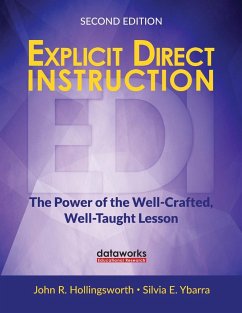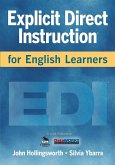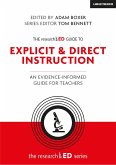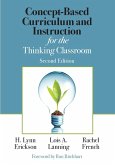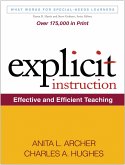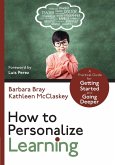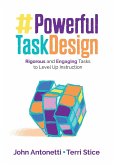John R. Hollingsworth (DataWORKS Educational Research), Silvia E. Ybarra (DataWORKS Educational Research)
Explicit Direct Instruction (EDI)
The Power of the Well-Crafted, Well-Taught Lesson
John R. Hollingsworth (DataWORKS Educational Research), Silvia E. Ybarra (DataWORKS Educational Research)
Explicit Direct Instruction (EDI)
The Power of the Well-Crafted, Well-Taught Lesson
- Broschiertes Buch
- Merkliste
- Auf die Merkliste
- Bewerten Bewerten
- Teilen
- Produkt teilen
- Produkterinnerung
- Produkterinnerung
Written in an entertaining, teacher-friendly, easy to read style with classroom examples, boxed features, and detailed sample lessons, the book covers checking for understanding, lesson objectives, activating prior knowledge, concept and skills development, guided practice, and much more.
Andere Kunden interessierten sich auch für
![Explicit Direct Instruction for English Learners Explicit Direct Instruction for English Learners]() John R. HollingsworthExplicit Direct Instruction for English Learners35,99 €
John R. HollingsworthExplicit Direct Instruction for English Learners35,99 €![The researchED Guide to Explicit and Direct Instruction The researchED Guide to Explicit and Direct Instruction]() The researchED Guide to Explicit and Direct Instruction18,99 €
The researchED Guide to Explicit and Direct Instruction18,99 €![Concept-Based Curriculum and Instruction for the Thinking Classroom Concept-Based Curriculum and Instruction for the Thinking Classroom]() H. Lynn EricksonConcept-Based Curriculum and Instruction for the Thinking Classroom34,99 €
H. Lynn EricksonConcept-Based Curriculum and Instruction for the Thinking Classroom34,99 €![Explicit Instruction Explicit Instruction]() Anita L. ArcherExplicit Instruction60,99 €
Anita L. ArcherExplicit Instruction60,99 €![How to Personalize Learning How to Personalize Learning]() Barbara A. BrayHow to Personalize Learning36,99 €
Barbara A. BrayHow to Personalize Learning36,99 €![Powerful Task Design Powerful Task Design]() John V. AntonettiPowerful Task Design36,99 €
John V. AntonettiPowerful Task Design36,99 €![Direct Instruction Mathematics Direct Instruction Mathematics]() Marcy SteinDirect Instruction Mathematics146,99 €
Marcy SteinDirect Instruction Mathematics146,99 €-
-
-
Written in an entertaining, teacher-friendly, easy to read style with classroom examples, boxed features, and detailed sample lessons, the book covers checking for understanding, lesson objectives, activating prior knowledge, concept and skills development, guided practice, and much more.
Produktdetails
- Produktdetails
- Corwin Teaching Essentials
- Verlag: SAGE Publications Inc
- 2 Revised edition
- Seitenzahl: 250
- Erscheinungstermin: 29. September 2017
- Englisch
- Abmessung: 280mm x 216mm x 14mm
- Gewicht: 656g
- ISBN-13: 9781506337517
- ISBN-10: 1506337511
- Artikelnr.: 46474897
- Herstellerkennzeichnung
- Libri GmbH
- Europaallee 1
- 36244 Bad Hersfeld
- gpsr@libri.de
- Corwin Teaching Essentials
- Verlag: SAGE Publications Inc
- 2 Revised edition
- Seitenzahl: 250
- Erscheinungstermin: 29. September 2017
- Englisch
- Abmessung: 280mm x 216mm x 14mm
- Gewicht: 656g
- ISBN-13: 9781506337517
- ISBN-10: 1506337511
- Artikelnr.: 46474897
- Herstellerkennzeichnung
- Libri GmbH
- Europaallee 1
- 36244 Bad Hersfeld
- gpsr@libri.de
John Hollingsworth is president of DataWORKS Educational Research, a company originally created to use real data to improve student achievement. Although DataWORKS started by analyzing learning outcomes (test scores), it soon refocused towards analyzing learning inputs (classroom instructional practices). DataWORKS now focuses mainly on providing staff development to schools on classroom instruction. John is an active researcher and presenter and has published numerous articles in educational publications. He spends much of his time on the road training teachers.
Preface to the Second Edition: What's New in EDI
Acknowledgments
About the Authors
Chapter 1. Students Say, "I Can Do It!"
The Day I Saw the Breakthrough in Classroom Instruction
Where Our Research Began: Student Achievement
Where Our Research Led: Classroom Instruction
Chapter 2. Are Some Approaches Better Than Others? What Is Effective
Instruction?
Why Are Children Sent to School? Talent Discovery Versus Talent Development
The Teaching/Learning Dilemma: Speed Up or Slow Down
Criteria for an Instructional Approach
Two Philosophies About Education
High-Stakes Testing
What to Do?
EDI Is Not Lecturing
EDI Is Not Scripted
Research Supports Direct Instruction
When to Use Group Work
Chapter 3. Good Instruction Is Always Good Instruction: An Explicit Direct
Instruction Overview
What Is Explicit Direct Instruction?
Explicit Direct Instruction Lesson Design
Explicit Direct Instruction Lesson Delivery
How to Use EDI in Your Classroom
Chapter 4. Creating Engaged Students: Use Engagement Norms!
Student Engagement Is Created When You Ask Your Students to Do Something
History of Student Engagement Norms
Student Engagement Norm 1: Pronounce With Me
Student Engagement Norm 2: Track With Me
Student Engagement Norm 3: Read With Me
Student Engagement Norm 4: Gesture With Me
Student Engagement Norm 5: Pair-Share
Student Engagement Norm 6: Attention Signal
Student Engagement Norm 7: Whiteboards
Student Engagement Norm 8: Use Complete Sentences (Public Voice, Academic
Vocabulary)
Training Students in the Engagement Norms
Summary
Chapter 5. Is Everyone Learning? Checking for Understanding
What Is Checking for Understanding?
TAPPLE-Checking for Understanding the EDI Way!
Teach First
Ask a Specific Question
Pair-Share
Pick a Non-Volunteer
Listen Carefully to the Response
Effective Feedback
Summary
Chapter 6. Everyone Learns: Corrective Feedback and Whiteboards
Listen Carefully to the Response
Effective Feedback
Whiteboards, the Best Way to CFU!
Summary
Chapter 7. Establishing What Is Going to Be Taught: Learning Objective
Part I: Well-Designed Learning Objectives
Part II: Writing Standards-Based Learning Objectives
Part III: The Learning Objective Must Be Presented to the Students
Summary
Chapter 8. Connecting to What Students Already Know: Activating Prior
Knowledge
Part I: What Does It Mean to Activate Prior Knowledge?
Part II: How to Activate Prior Knowledge
Summary
Chapter 9. These Are the Big Ideas: Concept Development
Part I: Concept Development Design
Part II: Concept Development Delivery
Summary
Chapter 10. I'll Work a Problem First: Rule of Two- Skill Development and
Guided Practice
Skill Development (Teacher)
Guided Practice (Students)
How to Design Skill Development and Guided Practice
How to Teach Skill Development/Guided Practice
Summary
Chapter 11. This Is Important to Learn: Relevance
Relevance
When Do You Teach Lesson Relevance?
How Do You Provide Lesson Relevance?
How to Design Lesson Relevance
How to Teach Lesson Relevance
Summary
Chapter 12. Making One Final Check: Closing the Lesson
Closing the Lesson
How to Provide Lesson Closure
When Closure Is Complete, Initiate Independent Practice
Chapter 13. Planning for Success: Differentiation and Scaffolding
Differentiating and Scaffolding to Increase Student Success
In-Class Interventions and Out-of-Class Interventions
Response to Intervention (RTI) and EDI
Summary
Chapter 14. Having Students Work by Themselves: Independent Practice and
Periodic Review
Starting With the End in Mind: The Independent Practice Must Match the
Lesson
Periodic Review
Summary
Chapter 15. Creating Well-Crafted Lessons: Putting It All Together
Creating EDI Lessons From a Textbook
Creating Your Own EDI Lessons
DataWORKS Enters the Classroom to Teach
Chapter 16. Looking at All the Components: Analyzing a Sample Lesson
Use educeri.com for EDI Lessons
EDI Lesson Layout
Summary
Resources: What the Research Says
References
Index
Acknowledgments
About the Authors
Chapter 1. Students Say, "I Can Do It!"
The Day I Saw the Breakthrough in Classroom Instruction
Where Our Research Began: Student Achievement
Where Our Research Led: Classroom Instruction
Chapter 2. Are Some Approaches Better Than Others? What Is Effective
Instruction?
Why Are Children Sent to School? Talent Discovery Versus Talent Development
The Teaching/Learning Dilemma: Speed Up or Slow Down
Criteria for an Instructional Approach
Two Philosophies About Education
High-Stakes Testing
What to Do?
EDI Is Not Lecturing
EDI Is Not Scripted
Research Supports Direct Instruction
When to Use Group Work
Chapter 3. Good Instruction Is Always Good Instruction: An Explicit Direct
Instruction Overview
What Is Explicit Direct Instruction?
Explicit Direct Instruction Lesson Design
Explicit Direct Instruction Lesson Delivery
How to Use EDI in Your Classroom
Chapter 4. Creating Engaged Students: Use Engagement Norms!
Student Engagement Is Created When You Ask Your Students to Do Something
History of Student Engagement Norms
Student Engagement Norm 1: Pronounce With Me
Student Engagement Norm 2: Track With Me
Student Engagement Norm 3: Read With Me
Student Engagement Norm 4: Gesture With Me
Student Engagement Norm 5: Pair-Share
Student Engagement Norm 6: Attention Signal
Student Engagement Norm 7: Whiteboards
Student Engagement Norm 8: Use Complete Sentences (Public Voice, Academic
Vocabulary)
Training Students in the Engagement Norms
Summary
Chapter 5. Is Everyone Learning? Checking for Understanding
What Is Checking for Understanding?
TAPPLE-Checking for Understanding the EDI Way!
Teach First
Ask a Specific Question
Pair-Share
Pick a Non-Volunteer
Listen Carefully to the Response
Effective Feedback
Summary
Chapter 6. Everyone Learns: Corrective Feedback and Whiteboards
Listen Carefully to the Response
Effective Feedback
Whiteboards, the Best Way to CFU!
Summary
Chapter 7. Establishing What Is Going to Be Taught: Learning Objective
Part I: Well-Designed Learning Objectives
Part II: Writing Standards-Based Learning Objectives
Part III: The Learning Objective Must Be Presented to the Students
Summary
Chapter 8. Connecting to What Students Already Know: Activating Prior
Knowledge
Part I: What Does It Mean to Activate Prior Knowledge?
Part II: How to Activate Prior Knowledge
Summary
Chapter 9. These Are the Big Ideas: Concept Development
Part I: Concept Development Design
Part II: Concept Development Delivery
Summary
Chapter 10. I'll Work a Problem First: Rule of Two- Skill Development and
Guided Practice
Skill Development (Teacher)
Guided Practice (Students)
How to Design Skill Development and Guided Practice
How to Teach Skill Development/Guided Practice
Summary
Chapter 11. This Is Important to Learn: Relevance
Relevance
When Do You Teach Lesson Relevance?
How Do You Provide Lesson Relevance?
How to Design Lesson Relevance
How to Teach Lesson Relevance
Summary
Chapter 12. Making One Final Check: Closing the Lesson
Closing the Lesson
How to Provide Lesson Closure
When Closure Is Complete, Initiate Independent Practice
Chapter 13. Planning for Success: Differentiation and Scaffolding
Differentiating and Scaffolding to Increase Student Success
In-Class Interventions and Out-of-Class Interventions
Response to Intervention (RTI) and EDI
Summary
Chapter 14. Having Students Work by Themselves: Independent Practice and
Periodic Review
Starting With the End in Mind: The Independent Practice Must Match the
Lesson
Periodic Review
Summary
Chapter 15. Creating Well-Crafted Lessons: Putting It All Together
Creating EDI Lessons From a Textbook
Creating Your Own EDI Lessons
DataWORKS Enters the Classroom to Teach
Chapter 16. Looking at All the Components: Analyzing a Sample Lesson
Use educeri.com for EDI Lessons
EDI Lesson Layout
Summary
Resources: What the Research Says
References
Index
Preface to the Second Edition: What's New in EDI
Acknowledgments
About the Authors
Chapter 1. Students Say, "I Can Do It!"
The Day I Saw the Breakthrough in Classroom Instruction
Where Our Research Began: Student Achievement
Where Our Research Led: Classroom Instruction
Chapter 2. Are Some Approaches Better Than Others? What Is Effective
Instruction?
Why Are Children Sent to School? Talent Discovery Versus Talent Development
The Teaching/Learning Dilemma: Speed Up or Slow Down
Criteria for an Instructional Approach
Two Philosophies About Education
High-Stakes Testing
What to Do?
EDI Is Not Lecturing
EDI Is Not Scripted
Research Supports Direct Instruction
When to Use Group Work
Chapter 3. Good Instruction Is Always Good Instruction: An Explicit Direct
Instruction Overview
What Is Explicit Direct Instruction?
Explicit Direct Instruction Lesson Design
Explicit Direct Instruction Lesson Delivery
How to Use EDI in Your Classroom
Chapter 4. Creating Engaged Students: Use Engagement Norms!
Student Engagement Is Created When You Ask Your Students to Do Something
History of Student Engagement Norms
Student Engagement Norm 1: Pronounce With Me
Student Engagement Norm 2: Track With Me
Student Engagement Norm 3: Read With Me
Student Engagement Norm 4: Gesture With Me
Student Engagement Norm 5: Pair-Share
Student Engagement Norm 6: Attention Signal
Student Engagement Norm 7: Whiteboards
Student Engagement Norm 8: Use Complete Sentences (Public Voice, Academic
Vocabulary)
Training Students in the Engagement Norms
Summary
Chapter 5. Is Everyone Learning? Checking for Understanding
What Is Checking for Understanding?
TAPPLE-Checking for Understanding the EDI Way!
Teach First
Ask a Specific Question
Pair-Share
Pick a Non-Volunteer
Listen Carefully to the Response
Effective Feedback
Summary
Chapter 6. Everyone Learns: Corrective Feedback and Whiteboards
Listen Carefully to the Response
Effective Feedback
Whiteboards, the Best Way to CFU!
Summary
Chapter 7. Establishing What Is Going to Be Taught: Learning Objective
Part I: Well-Designed Learning Objectives
Part II: Writing Standards-Based Learning Objectives
Part III: The Learning Objective Must Be Presented to the Students
Summary
Chapter 8. Connecting to What Students Already Know: Activating Prior
Knowledge
Part I: What Does It Mean to Activate Prior Knowledge?
Part II: How to Activate Prior Knowledge
Summary
Chapter 9. These Are the Big Ideas: Concept Development
Part I: Concept Development Design
Part II: Concept Development Delivery
Summary
Chapter 10. I'll Work a Problem First: Rule of Two- Skill Development and
Guided Practice
Skill Development (Teacher)
Guided Practice (Students)
How to Design Skill Development and Guided Practice
How to Teach Skill Development/Guided Practice
Summary
Chapter 11. This Is Important to Learn: Relevance
Relevance
When Do You Teach Lesson Relevance?
How Do You Provide Lesson Relevance?
How to Design Lesson Relevance
How to Teach Lesson Relevance
Summary
Chapter 12. Making One Final Check: Closing the Lesson
Closing the Lesson
How to Provide Lesson Closure
When Closure Is Complete, Initiate Independent Practice
Chapter 13. Planning for Success: Differentiation and Scaffolding
Differentiating and Scaffolding to Increase Student Success
In-Class Interventions and Out-of-Class Interventions
Response to Intervention (RTI) and EDI
Summary
Chapter 14. Having Students Work by Themselves: Independent Practice and
Periodic Review
Starting With the End in Mind: The Independent Practice Must Match the
Lesson
Periodic Review
Summary
Chapter 15. Creating Well-Crafted Lessons: Putting It All Together
Creating EDI Lessons From a Textbook
Creating Your Own EDI Lessons
DataWORKS Enters the Classroom to Teach
Chapter 16. Looking at All the Components: Analyzing a Sample Lesson
Use educeri.com for EDI Lessons
EDI Lesson Layout
Summary
Resources: What the Research Says
References
Index
Acknowledgments
About the Authors
Chapter 1. Students Say, "I Can Do It!"
The Day I Saw the Breakthrough in Classroom Instruction
Where Our Research Began: Student Achievement
Where Our Research Led: Classroom Instruction
Chapter 2. Are Some Approaches Better Than Others? What Is Effective
Instruction?
Why Are Children Sent to School? Talent Discovery Versus Talent Development
The Teaching/Learning Dilemma: Speed Up or Slow Down
Criteria for an Instructional Approach
Two Philosophies About Education
High-Stakes Testing
What to Do?
EDI Is Not Lecturing
EDI Is Not Scripted
Research Supports Direct Instruction
When to Use Group Work
Chapter 3. Good Instruction Is Always Good Instruction: An Explicit Direct
Instruction Overview
What Is Explicit Direct Instruction?
Explicit Direct Instruction Lesson Design
Explicit Direct Instruction Lesson Delivery
How to Use EDI in Your Classroom
Chapter 4. Creating Engaged Students: Use Engagement Norms!
Student Engagement Is Created When You Ask Your Students to Do Something
History of Student Engagement Norms
Student Engagement Norm 1: Pronounce With Me
Student Engagement Norm 2: Track With Me
Student Engagement Norm 3: Read With Me
Student Engagement Norm 4: Gesture With Me
Student Engagement Norm 5: Pair-Share
Student Engagement Norm 6: Attention Signal
Student Engagement Norm 7: Whiteboards
Student Engagement Norm 8: Use Complete Sentences (Public Voice, Academic
Vocabulary)
Training Students in the Engagement Norms
Summary
Chapter 5. Is Everyone Learning? Checking for Understanding
What Is Checking for Understanding?
TAPPLE-Checking for Understanding the EDI Way!
Teach First
Ask a Specific Question
Pair-Share
Pick a Non-Volunteer
Listen Carefully to the Response
Effective Feedback
Summary
Chapter 6. Everyone Learns: Corrective Feedback and Whiteboards
Listen Carefully to the Response
Effective Feedback
Whiteboards, the Best Way to CFU!
Summary
Chapter 7. Establishing What Is Going to Be Taught: Learning Objective
Part I: Well-Designed Learning Objectives
Part II: Writing Standards-Based Learning Objectives
Part III: The Learning Objective Must Be Presented to the Students
Summary
Chapter 8. Connecting to What Students Already Know: Activating Prior
Knowledge
Part I: What Does It Mean to Activate Prior Knowledge?
Part II: How to Activate Prior Knowledge
Summary
Chapter 9. These Are the Big Ideas: Concept Development
Part I: Concept Development Design
Part II: Concept Development Delivery
Summary
Chapter 10. I'll Work a Problem First: Rule of Two- Skill Development and
Guided Practice
Skill Development (Teacher)
Guided Practice (Students)
How to Design Skill Development and Guided Practice
How to Teach Skill Development/Guided Practice
Summary
Chapter 11. This Is Important to Learn: Relevance
Relevance
When Do You Teach Lesson Relevance?
How Do You Provide Lesson Relevance?
How to Design Lesson Relevance
How to Teach Lesson Relevance
Summary
Chapter 12. Making One Final Check: Closing the Lesson
Closing the Lesson
How to Provide Lesson Closure
When Closure Is Complete, Initiate Independent Practice
Chapter 13. Planning for Success: Differentiation and Scaffolding
Differentiating and Scaffolding to Increase Student Success
In-Class Interventions and Out-of-Class Interventions
Response to Intervention (RTI) and EDI
Summary
Chapter 14. Having Students Work by Themselves: Independent Practice and
Periodic Review
Starting With the End in Mind: The Independent Practice Must Match the
Lesson
Periodic Review
Summary
Chapter 15. Creating Well-Crafted Lessons: Putting It All Together
Creating EDI Lessons From a Textbook
Creating Your Own EDI Lessons
DataWORKS Enters the Classroom to Teach
Chapter 16. Looking at All the Components: Analyzing a Sample Lesson
Use educeri.com for EDI Lessons
EDI Lesson Layout
Summary
Resources: What the Research Says
References
Index

